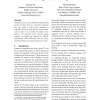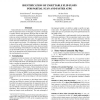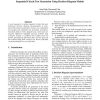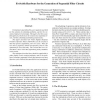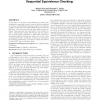ACSD
2010
IEEE
14 years 5 months ago
2010
IEEE
Digital components play a central role in the design of complex embedded systems. These components are interconnected with other, possibly analog, devices and the physical environm...
ISLPED
2000
ACM
14 years 11 months ago
2000
ACM
This paper presents a state assignment technique called priority encoding which uses multi-code assignment plus clock gating to reduce power dissipation in sequential circuits. Th...
ICCAD
1996
IEEE
14 years 11 months ago
1996
IEEE
State justification is a time-consuming operation in test generation for sequential circuits. In this paper, we present a technique to rapidly identify state elements (flip-flops)...
ICCD
1997
IEEE
14 years 11 months ago
1997
IEEE
Abstract— In this paper we consider the problem of clustering sequential circuits subject to a bound on the area of each cluster, with the objective of minimizing the clock perio...
DATE
1999
IEEE
14 years 11 months ago
1999
IEEE
A novel approach to testing sequential circuits that uses multi-level decision diagram representations is introduced. The proposed algorithm consists of a combination of scanning ...
ATS
2000
IEEE
14 years 11 months ago
2000
IEEE
We present a new test generation procedure for sequential circuits using newly traversed state and newly detected fault information obtained between successive iterations of vecto...
EH
2002
IEEE
15 years 7 days ago
2002
IEEE
Evolutionary algorithms (EAs) are regularly used both for the solution of scheduling problems, and for the creation of digital circuit designs. This paper describes a unified app...
DAC
2006
ACM
15 years 1 months ago
2006
ACM
In this paper, we propose a novel technique on mining relationships in a sequential circuit to discover global constraints. In contrast to the traditional learning methods, our mi...
DFT
2007
IEEE
15 years 1 months ago
2007
IEEE
The paper discusses a novel approach for reduction of fault detection latency in a selfchecking sequential circuit. The Authors propose decomposing the finite state machine (FSM) ...
DATE
2007
IEEE
15 years 1 months ago
2007
IEEE
Due to reduction in device feature size and supply voltage, the sensitivity to radiation induced transient faults (soft errors) of digital systems increases dramatically. Intensiv...

